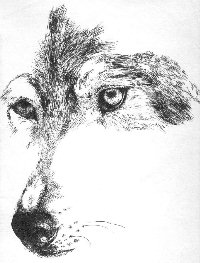

For centuries, the wolf has enchanted us with its unending perseverance, its cunning intelligence, and, more than anything else, its untamed heart. Unfortunately, there are those who feel threatened by wolves, a fear that stems from years of listening to Little Red Riding Hood, the Three Little Pigs and other outlandish folklore. The "Big Bad Wolf" does not exist, except in our own imaginations. Granted, real wolves are real predators who hunt and kill to sustain their families but they are also a necessity in our ecosystem. Their presence provides the balance that is integral to preserving the natural beauty of our North American wilderness. The detrimental impact of wolf populations is all too often exaggerated. It cannot be emphasized enough: no healthy wolf has ever seriously injured a human.
The Appearance of a Wolf The color of a wolf's fur is usually grayish, although black, white, and reddish complexions are not unheard of. The thickness of their coat depends on the climate of their geographic region. Colder areas mean thicker fur, whereas wolves in warmer locations generally have shorter, thinner coats. A wolf has 5 toes on its forepaw and only 4 toes on its hindpaw. Non-retractable claws on each paw help bring down the large prey they usually hunt. Both wolves and dogs share several canine characteristics: a long muzzle, pointed ears, and sharp teeth. An adult wolf (minus the tail) is usually around 50 inches long, and can weigh as heavy as 180 lbs. Male wolves tend to be on the heavier side.
The Family Unit Wolves are very social animals, with the ability to communicate their thoughts and intentions just as easily as humans. Wolf packs can range from 3 to 30+ members. The average pack, however, usually consists of around 8 to 12 wolves. A large local food supply generally raises the number of wolves in a pack. The pack leader is known as the alpha male, who rules over the other wolves with the alpha female. They are the only ones who are allowed to procreate and also have the sole privilege of being the first ones to eat. This hierarchy is sometimes challenged by others within the pack, with only the bravest attempting to seize control from the existing alpha male. The outcome of such a fight can result in a change of leadership or, in some cases, the demotion or expulsion of the former leader or the defeated challenger. Wolves banished from the pack become known as lone wolves, who sometimes travel vast distances in search of a new mate and a new place to hunt. Some lone wolves simply linger behind another wolf pack, gobbling up whatever is left on an abandoned carcass.
Communication Wolves are capable of displaying emotions in the same fashion as humans by using facial, verbal, and bodily expressions. A wolf's tail is arguably the most significant visible indicator of emotional expression. Aggression in usually conveyed through intimidating snarls, exposing the teeth, and a stiffened tail curled upwards. Submission is shown by a cowering posture -- a lowered head, ears flattened, and tail tucked in between the hind legs. The weakest wolves in a pack are always submissive towards the others, sometimes even rolling on their back as a final show of defenselessness. Wolves yelp when unsatisfied, cry for help, and bark when either playing or fighting. A wolf's howl is both beautiful and chilling. One can almost detect a hint of sadness in every wolf's tone.
Wolf Cubs A wolf mother carries her offspring for a period of around 60 days before giving birth. Cubs are born blind, their eyes remaining closed until later. The average litter ranges from about 4 to 8 cubs. During the first few weeks, the mother nurtures and looks after the cubs while the male hunts and returns with food. After 3 weeks, they begin to explore areas outside the den. Wolf cubs play, fight, and chase each other around, learning the necessary skills for hunting and surviving while also getting their first taste of the hierarchical structure within the wolf pack. As wolf cubs grow older and more experienced, they refine the abilities that will allow them to join the other wolves in the hunt.
Wolf Dens Before giving birth, a pregnant female searches for an isolated spot to have her cubs. Generally, a wolf den is a cave, a hollowed tree trunk, or some other natural construction. At times, wolves will build the den themselves, digging a hole suitable for raising a family. Wolf cubs must be sheltered from owls and other birds of prey. A wolf mother can use the same den for years, so long as its safe, peaceful, and close to food and water sources. A wolf pack might occupy a region of wilderness that can span for kilometers. A pack travels constantly, moving in single file behind the leader. The unclaimed area between different wolf packs is sometimes populated by lone wolves. A physical conflict is bound to happen whenever packs from different territories intrude on each other's hunting grounds.
Humans and Their Impact on Wolves
Unfortunately, many people fear the wolf, believing this animal to be some
incarnation of evil and malevolence. Wolf attacks on cattle and sheep
populations have been greatly exaggerated throughout the years but humans
still exterminate these animals regardless. Hunting, traps, and poison are
only some of the methods used by humans to endanger the wolf's existence.
Although the wolf's future is by no means guaranteed, several countries
have passed protective laws forbidding the needless persecution of wolves.
It should be noted that only 1/10 of 1% of livestock are lost to wolves.
Take a look at my wolf pictures. It may take a little while
to load though so be patient.
| LinkExchange Member | Free Home Pages at GeoCities |